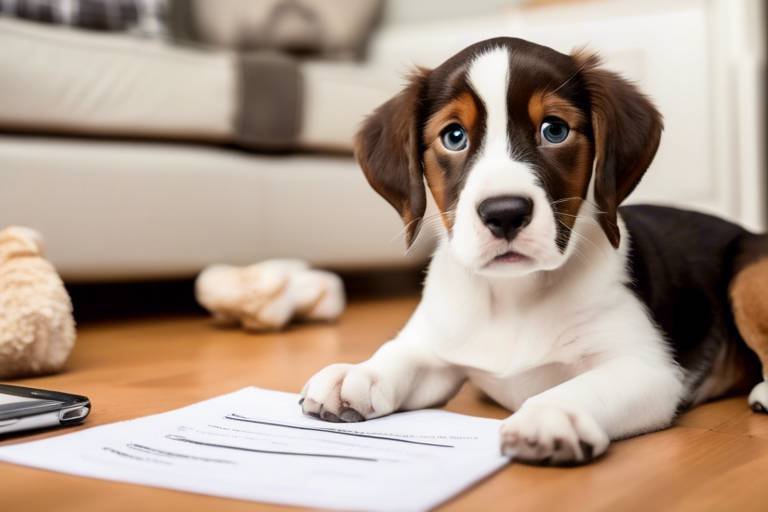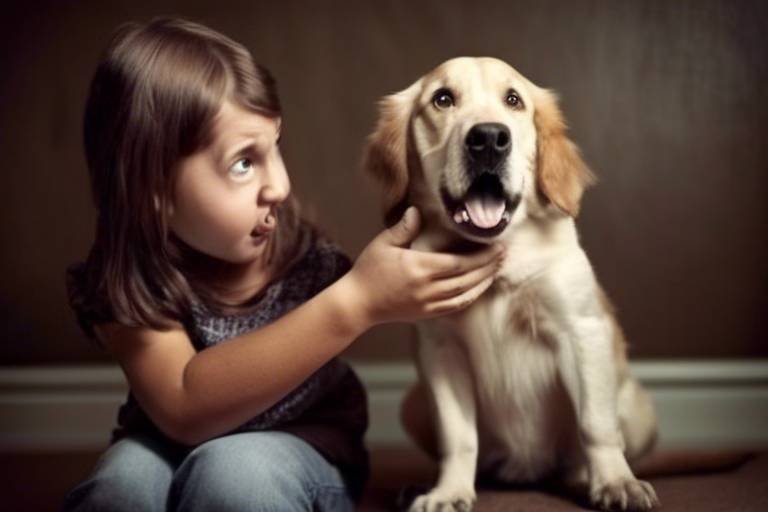What to Do If Your Pet Experiences Fainting
When your beloved furry friend suddenly goes limp and falls to the ground, it can be one of the most frightening experiences a pet owner can face. Fainting, also known as syncope, is not just a simple case of your pet feeling light-headed; it can indicate underlying health issues that require immediate attention. So, what should you do when you witness such an alarming event? First and foremost, stay calm. Your pet can sense your anxiety, and keeping a level head will help you respond more effectively. In this article, we will guide you through essential steps to take if your pet experiences fainting, ensuring you know how to act swiftly and appropriately to safeguard their health.
Understanding the situation is crucial. Fainting can manifest in various ways, and recognizing the signs can help you determine whether your pet needs urgent care. It's vital to differentiate between fainting and other conditions like seizures, which can look similar but have different implications. If your pet has fainted, observe them closely for any unusual behavior or symptoms that follow the fainting episode. This could include confusion, weakness, or even a brief period of unresponsiveness. Keeping a detailed account of what happened can be beneficial when you consult your veterinarian.
After ensuring your pet is in a safe environment, it’s important to check their vital signs. Assessing breathing and pulse can provide critical information about their condition. To check for breathing, look for the rise and fall of their chest or feel for breath against your cheek. For their pulse, gently place your fingers on the inside of their leg, where the femoral artery is located. If you can't detect a pulse or if their breathing is irregular, seek veterinary assistance immediately. Remember, acting quickly can make a significant difference in your pet's health outcomes.
While waiting for professional help, it’s essential to keep your pet calm. After a fainting episode, pets can be disoriented and anxious, much like how we feel after waking from a deep sleep. Speak to them in soothing tones, and avoid any sudden movements that might startle them. Creating a comfortable space can help them regain their composure. If your pet is conscious and responsive, offer them water to help rehydrate, but avoid forcing them to drink if they seem unsteady or confused.
As you navigate this stressful situation, keep in mind that fainting can stem from various causes, including cardiovascular issues or neurological factors. Understanding these potential underlying problems will empower you to ask the right questions when you visit your vet. Don't hesitate to share any observations you made during the fainting episode, as this information can be invaluable in diagnosing your pet's condition.
- What should I do immediately after my pet faints? Stay calm, check their breathing and pulse, and keep them in a safe, quiet environment.
- How can I tell if my pet is having a seizure instead of fainting? Seizures often involve involuntary muscle movements, whereas fainting is characterized by a sudden loss of consciousness without muscle spasms.
- When should I take my pet to the vet after a fainting episode? If your pet does not regain consciousness within a few minutes or shows other concerning symptoms, seek veterinary care immediately.
- Can fainting be prevented? While some causes of fainting may not be preventable, regular veterinary check-ups can help catch underlying health issues early.

Understanding Fainting in Pets
Fainting, also known as syncope, can be a distressing experience for both pets and their owners. Imagine your furry friend suddenly collapsing, seemingly lifeless for a moment—it's enough to make anyone's heart race. But what exactly is fainting? In simple terms, it's a temporary loss of consciousness due to a lack of blood flow to the brain. This can happen in pets just like it does in humans, and understanding the nuances of this condition is crucial for any pet owner.
When a pet faints, it may exhibit a few telltale signs. Before the episode, you might notice your pet becoming unusually weak or lethargic. During the fainting spell, they may fall over, and their body might go limp. After regaining consciousness, pets often appear disoriented and confused, which can be quite alarming to witness. It's essential to differentiate fainting from other medical conditions, such as seizures, which involve more pronounced muscle activity and may last longer. While seizures can be alarming, fainting is generally a brief episode, lasting just a few seconds to a minute.
Understanding the difference between fainting and seizures is vital. Here’s a quick comparison:
| Feature | Fainting (Syncope) | Seizures |
|---|---|---|
| Duration | Seconds to a minute | Seconds to several minutes |
| Muscle Activity | Limp body | Involuntary muscle contractions |
| Post-Episode Behavior | Disoriented but often recovers quickly | May be confused or lethargic for a longer period |
In addition to these signs, pet owners should be aware that fainting can be triggered by various factors, including stress, overheating, or underlying health issues. For instance, a sudden fright or a spike in temperature could lead to a fainting episode. Thus, it’s important to observe your pet's behavior and environment closely.
In summary, while fainting can be a frightening experience, understanding its nature and symptoms can help you respond effectively. Always keep an eye on your pet's overall health and behavior, and don’t hesitate to seek veterinary care if you notice any unusual patterns. After all, being proactive about your pet's health is one of the best ways to ensure their happiness and longevity.

Common Causes of Fainting in Pets
Fainting in pets can be a puzzling and distressing experience for pet owners. Understanding the common causes of fainting is crucial for ensuring your furry friend receives the proper care they need. While it might be tempting to think of fainting as a singular event, it often has underlying reasons that can range from benign to serious. In this section, we will delve into some of the most prevalent causes of fainting in pets, helping you to recognize potential red flags and seek timely veterinary attention.
One of the primary culprits behind fainting spells in pets is related to cardiovascular issues. The heart is a vital organ, and any dysfunction can lead to a lack of blood flow to the brain, resulting in syncope. Conditions such as arrhythmias, where the heart beats irregularly, or heart murmurs, which indicate abnormal blood flow, can significantly affect your pet's health. These conditions often manifest through symptoms like lethargy, coughing, or difficulty breathing, so being vigilant about your pet's behavior is essential.
Another significant factor to consider is neurological problems. Fainting can sometimes be confused with seizures, but the two are distinct. Seizures can be caused by a variety of issues, including brain tumors or epilepsy, and they often present with more pronounced symptoms such as convulsions or loss of muscle control. It's vital to differentiate between these conditions, as they require different approaches to treatment and management.
Additionally, dehydration and heatstroke can also lead to fainting. When pets become dehydrated, their blood volume decreases, which can lead to a drop in blood pressure and result in fainting. Similarly, overheating can cause a rapid increase in heart rate and blood pressure, which may overwhelm the body's ability to cope, leading to syncope. Keeping your pet well-hydrated and cool during hot weather is essential for their overall health.
Other causes can include metabolic disorders such as diabetes or thyroid issues, which can disrupt normal bodily functions and lead to fainting spells. These conditions may present with additional symptoms like increased thirst, frequent urination, or changes in appetite, making it important for pet owners to monitor their pets closely for any signs of distress.
In summary, while fainting can be alarming, understanding the potential causes can help you respond appropriately. If your pet experiences fainting, it’s important to consider these factors and consult with your veterinarian for a thorough evaluation. Remember, early intervention can make a significant difference in your pet's health outcomes.
- What should I do if my pet faints? Immediately check for breathing and pulse, and keep your pet calm. If they do not regain consciousness quickly, seek veterinary attention.
- Can fainting in pets be a sign of a serious condition? Yes, fainting can indicate serious health issues such as heart problems or neurological disorders, so it's important to consult a vet.
- How can I prevent my pet from fainting? Regular check-ups, a balanced diet, and keeping your pet hydrated can help prevent fainting spells.
Cardiovascular Issues
When it comes to our furry companions, their health is often a top priority, and can be particularly concerning. These heart-related problems are one of the leading causes of fainting, or syncope, in pets. Just like in humans, the heart is a vital organ that pumps blood throughout the body, providing essential nutrients and oxygen. If something goes awry with this system, it can lead to serious consequences, including fainting spells.
Conditions such as arrhythmias—which are irregular heartbeats—can disrupt the normal flow of blood, causing a sudden drop in blood pressure and leading to fainting. Another common issue is heart murmurs, which can indicate underlying heart disease. Both of these conditions can manifest subtly at first, making it crucial for pet owners to be vigilant and observant of their pet's behavior.
To better understand the impact of cardiovascular issues on your pet, consider the following table that outlines some common heart-related conditions and their potential symptoms:
| Condition | Symptoms |
|---|---|
| Arrhythmia | Weakness, lethargy, fainting, rapid breathing |
| Heart Murmur | Exercise intolerance, coughing, fainting |
| Cardiomyopathy | Swollen abdomen, lethargy, fainting, difficulty breathing |
Recognizing the symptoms associated with these cardiovascular issues is crucial for early detection and intervention. For example, if you notice your pet becoming unusually tired after light exercise or if they seem to have trouble catching their breath, it’s essential to consult a veterinarian. Early diagnosis can make a significant difference in treatment outcomes, potentially preventing more severe health complications down the line.
Veterinarians often recommend various diagnostic procedures to assess heart health. These can include an Electrocardiogram (ECG), which measures the electrical activity of the heart, and an echocardiogram, which uses ultrasound to visualize the heart's structure and function. These tests are non-invasive and can provide invaluable insights into your pet's cardiovascular health.
In summary, being aware of the signs and symptoms of cardiovascular issues in pets can be a game-changer for pet owners. Regular check-ups and being proactive about your pet's health can help catch problems early, ensuring your furry friend remains happy and healthy. Remember, when it comes to your pet's heart health, the sooner you act, the better the outcome.
- What are the signs of fainting in pets? Look for sudden collapse, unresponsiveness, and a lack of coordination.
- How can I tell if my pet has a heart problem? Symptoms may include lethargy, coughing, and difficulty breathing.
- What should I do if my pet faints? Ensure their safety, check for breathing and pulse, and contact a veterinarian immediately.
- Are cardiovascular issues common in all pets? Certain breeds are more prone to heart conditions, but all pets can be affected.
Identifying Symptoms
Recognizing the symptoms associated with cardiovascular issues in pets is crucial for timely intervention and care. Often, the signs may be subtle or easily overlooked, making it essential for pet owners to be vigilant. One of the most common indicators of potential heart problems is excessive panting. If your pet seems to be breathing heavily even when at rest, it could signal underlying cardiac distress.
Another symptom to watch for is weakness or lethargy. If your furry friend is less active than usual or struggles to engage in their favorite activities, it might be a red flag. Additionally, collapse or fainting episodes can occur without warning, leaving pet owners feeling helpless. In some cases, you might notice your pet coughing frequently, especially during or after exercise, which can indicate fluid buildup in the lungs due to heart failure.
Moreover, keep an eye out for any signs of abdominal swelling. This can be a sign of heart disease, as fluid may accumulate in the abdomen. If you notice that your pet has a decreased appetite or is showing signs of distress or discomfort, it’s crucial to consult with a veterinarian. These symptoms can manifest in various ways, and understanding them can help you act quickly.
Here are some additional symptoms that may indicate heart issues in your pet:
- Rapid heartbeat: An unusually fast heart rate can be a sign of arrhythmia.
- Fainting spells: Recurring fainting episodes require immediate veterinary attention.
- Behavior changes: Increased irritability or anxiety can sometimes be linked to health issues.
Being proactive in observing these signs can make all the difference in your pet's health. If you notice any of these symptoms, it’s essential to consult your veterinarian for a thorough examination. Early detection often leads to better outcomes, so don’t hesitate to seek help if something seems off.
Q: What should I do if my pet faints?
A: If your pet faints, check for breathing and pulse immediately. If they are not breathing or do not have a pulse, perform CPR and seek veterinary assistance right away.
Q: How can I tell if my pet is experiencing a seizure instead of fainting?
A: Seizures typically involve convulsions, muscle twitching, and a loss of awareness, while fainting generally results in a brief loss of consciousness without the jerking movements.
Q: Are certain breeds more prone to fainting?
A: Yes, some breeds have a higher predisposition to heart issues, such as Cavalier King Charles Spaniels and Boxers. Regular check-ups are essential for these breeds.
Q: Can fainting be a sign of something serious?
A: Yes, fainting can indicate serious underlying health issues, including heart disease or neurological problems. It’s important to consult a veterinarian for a thorough evaluation.
Diagnostic Procedures
When it comes to understanding why your pet might be fainting, play a crucial role. Just like how a detective gathers clues to solve a mystery, veterinarians employ various tests to uncover the underlying health issues affecting your furry friend. The first step typically involves a thorough physical examination, where the vet will assess your pet's overall health, check their heart rate, and look for any visible signs of distress or abnormalities.
Once the initial examination is complete, the veterinarian may recommend a series of diagnostic tests to get a clearer picture of your pet's condition. Some common procedures include:
- Electrocardiogram (ECG): This test measures the electrical activity of your pet's heart. It helps identify any irregular heartbeats or arrhythmias that could be causing fainting episodes.
- Echocardiogram: This ultrasound of the heart provides a detailed view of its structure and function, allowing vets to spot issues like heart murmurs or structural abnormalities.
- Blood Tests: A complete blood count (CBC) and biochemical profile can help assess your pet's overall health, including organ function and electrolyte levels, which are vital in diagnosing dehydration or metabolic issues.
- X-rays: Radiographs can reveal any abnormalities in the chest and abdomen, such as enlarged hearts or fluid buildup, which may contribute to fainting.
Each of these tests provides valuable information that helps the veterinarian determine the cause of your pet's fainting. It's important to remember that while these procedures may sound intimidating, they are generally safe and non-invasive. The goal is to pinpoint the issue as quickly as possible so that appropriate treatment can be initiated.
In some cases, your veterinarian might recommend further specialized tests, depending on the initial findings. For instance, if neurological issues are suspected, they may refer your pet for a neurological examination or even advanced imaging like an MRI. These additional tests can provide deeper insights into your pet's brain function and help rule out conditions such as tumors or severe neurological disorders.
Ultimately, the combination of these diagnostic procedures allows for a comprehensive understanding of your pet's health status. By working closely with your veterinarian and following their recommendations, you can ensure that your beloved companion receives the best possible care. Remember, early detection is key to effectively managing any health issues and improving your pet's quality of life.
- What should I do if my pet faints? - Stay calm, check for breathing and pulse, and ensure your pet is in a safe environment. Contact your veterinarian as soon as possible.
- Can fainting be a sign of a serious condition? - Yes, fainting can indicate underlying health problems, particularly related to the heart or neurological system. It's essential to have your pet evaluated by a veterinarian.
- How can I prevent my pet from fainting? - Regular veterinary check-ups, maintaining a healthy diet, and ensuring your pet stays hydrated can help prevent fainting episodes.
Neurological Factors
When it comes to our furry companions, their health is often a reflection of their overall well-being. One alarming issue that can arise is fainting, and in many cases, this can be linked to . Neurological problems can disrupt the normal functioning of the brain and nervous system, leading to episodes of syncope or loss of consciousness. Conditions such as seizures and brain tumors are among the most concerning neurological issues that can cause fainting spells in pets.
Seizures, for instance, can manifest in various forms, from mild twitching to full-body convulsions. A pet experiencing a seizure might appear dazed or confused, and once the episode subsides, they may seem disoriented, which can easily be mistaken for fainting. It's crucial for pet owners to understand that while fainting and seizures may look similar, they are fundamentally different. Fainting is typically a brief loss of consciousness due to a temporary drop in blood flow to the brain, while seizures are caused by abnormal electrical activity in the brain.
Another significant neurological condition that can lead to fainting is the presence of a brain tumor. Tumors can exert pressure on critical areas of the brain, disrupting normal functions, including those that regulate consciousness. Symptoms may vary widely depending on the tumor's location, but they often include changes in behavior, coordination issues, and, of course, fainting spells. If you notice any unusual behavior in your pet, it’s essential to consult a veterinarian for a thorough examination.
To better understand the potential neurological issues that could lead to fainting, consider the following table that outlines some common neurological conditions and their symptoms:
| Condition | Symptoms |
|---|---|
| Seizures | Twitching, loss of consciousness, confusion post-episode |
| Brain Tumors | Behavior changes, coordination issues, fainting |
| Vestibular Disease | Dizziness, loss of balance, head tilting |
In conclusion, neurological factors can play a significant role in the health of your pet and their propensity to faint. Understanding the signs and symptoms associated with these conditions is vital for prompt diagnosis and treatment. If your pet experiences fainting, it’s crucial to keep a close eye on their behavior and consult with a veterinarian to rule out any serious underlying neurological issues.
- What should I do if my pet faints? - Remain calm, check for breathing and pulse, and keep your pet safe until they regain consciousness.
- Can fainting in pets be serious? - Yes, fainting can indicate serious health issues, especially related to the heart or neurological system.
- How can I tell if my pet is having a seizure or fainting? - Seizures involve muscle contractions and may last longer than fainting, which is usually brief and followed by confusion.

Immediate Actions to Take
When your furry friend experiences fainting, it can be one of the most terrifying moments for any pet owner. The first thing you need to remember is to stay calm. Your pet can sense your anxiety, and a relaxed owner can help keep the situation from escalating. Immediate actions are crucial in ensuring your pet's safety and well-being. Here’s what you should do right after your pet faints.
First and foremost, check your pet's vital signs. This involves assessing both their breathing and pulse. To check for breathing, look for the rise and fall of their chest. You can also place your hand near their nose to feel for breath. For the pulse, gently place your fingers on their inner thigh or under their jaw. If you detect a pulse, it’s a good sign, but if you don’t, it’s time to act quickly. If your pet is not breathing or has no pulse, you may need to perform CPR. Remember, performing CPR on pets is different from humans. If you're unsure how to do it, consider looking up a reliable source or asking your veterinarian for guidance.
Next, it’s essential to keep your pet calm. After fainting, pets can often feel disoriented and scared, which could lead to further stress. Create a quiet, comfortable space for them to recover. You can gently stroke their fur and speak in a soothing voice. This not only reassures your pet but also helps to stabilize their heart rate and breathing. Providing a calm environment is vital for their recovery.
Once you’ve ensured that your pet is stable, it’s time to seek veterinary care. Even if your pet seems to recover quickly, it’s important to have them checked out by a professional. Fainting can be a sign of underlying health issues that need to be addressed. Don’t wait for another episode; schedule an appointment with your veterinarian as soon as possible. They may recommend diagnostic tests to determine the cause of the fainting, such as blood tests, X-rays, or even an ECG.
In the meantime, keep a record of your pet's fainting episode. Note the time it happened, how long it lasted, any other symptoms you observed, and what your pet was doing just before the incident. This information can be invaluable for your veterinarian in diagnosing the issue.
Here’s a quick summary of the immediate actions to take if your pet experiences fainting:
- Stay calm and assess your pet's breathing and pulse.
- Keep your pet in a quiet, comfortable environment.
- Seek veterinary care promptly.
- Document the episode for your vet.
Remember, while fainting can be alarming, being prepared and knowing how to respond can make a significant difference in your pet's health and safety.
Q: What should I do if my pet faints?
A: Stay calm, check for breathing and pulse, keep your pet calm, and seek veterinary care.
Q: Can fainting be a sign of a serious condition?
A: Yes, fainting can indicate underlying health issues, especially related to the heart or neurological system. Consult your veterinarian for a thorough examination.
Q: How can I tell the difference between fainting and a seizure?
A: Fainting typically involves a brief loss of consciousness without the convulsions or muscle spasms associated with seizures. Observing your pet's behavior before and after the episode can help determine what occurred.
Q: Is there any home care I can provide after my pet faints?
A: Ensure your pet is comfortable and calm. Monitor their behavior and vital signs closely until you can see a veterinarian.
Checking for Breathing and Pulse
When your pet experiences fainting, the first thing you need to do is remain calm. It’s natural to feel a wave of panic, but your pet will pick up on your emotions. Take a deep breath and focus on assessing their condition. Start by checking for breathing. Place your hand gently on their chest or watch for the rise and fall of their abdomen. If you notice that your pet is not breathing, you may need to perform CPR, but only if you are trained to do so.
Next, you’ll want to check for a pulse. You can do this by placing two fingers on the inside of their thigh, where the femoral artery is located. If you can feel a pulse, that’s a good sign, but if you can’t, it’s crucial to seek immediate veterinary assistance. Remember, the normal pulse rate for dogs is between 60-120 beats per minute, while cats usually range from 140-220 beats per minute. If you have a pet with a known heart condition, it’s wise to have their baseline rates documented for comparison during emergencies.
Here’s a quick reference table to help you understand normal vital signs for pets:
| Pet Type | Normal Heart Rate (bpm) | Normal Respiratory Rate (breaths/min) |
|---|---|---|
| Dog | 60-120 | 10-30 |
| Cat | 140-220 | 20-30 |
If your pet is breathing but seems disoriented or unresponsive, keep them in a quiet and safe environment. Avoid loud noises and sudden movements that could startle them. It’s also important to note any other symptoms they may be exhibiting, such as drooling, shaking, or unusual vocalizations, as these can provide vital clues to your veterinarian.
Ultimately, knowing how to check your pet's breathing and pulse can make a significant difference in their recovery. If you have any doubts or if their condition worsens, don’t hesitate to contact your veterinarian. Your prompt action could be critical in ensuring your pet receives the care they need.
- What should I do if my pet faints? - Stay calm, check for breathing and pulse, and seek veterinary care if necessary.
- How can I tell if my pet is breathing? - Look for the rise and fall of their chest or place your hand on their abdomen.
- What is a normal pulse rate for my dog or cat? - Refer to the table above for normal heart rates.
- When should I contact a veterinarian? - If your pet is unresponsive, not breathing, or if you have any concerns about their health.
Keeping Your Pet Calm
When your pet experiences fainting, it can be a frightening experience for both you and your furry friend. Their disorientation and confusion can create an atmosphere of panic, making it crucial to help them regain their composure. One of the first things you should do is to create a calm environment. This means minimizing noise, dimming the lights, and removing any potential stressors from the area. Just like humans, pets can pick up on our emotions, so your demeanor plays a significant role in how they react. If you remain calm and composed, your pet is more likely to feel secure.
In addition to creating a peaceful atmosphere, it's essential to approach your pet gently. Sudden movements or loud voices can startle them further. Speak softly and reassuringly, using a soothing tone to let them know that everything will be okay. You might say something like, "It's alright, buddy. You're safe now." This kind of verbal reassurance can work wonders in helping your pet feel more at ease.
Another effective technique is to offer physical comfort. Gently petting or stroking your pet can be incredibly calming. You can use slow, rhythmic motions to help them relax. Think of it like a comforting hug; it can help them feel grounded and secure. If your pet enjoys being cuddled, don’t hesitate to hold them close, but be mindful of their body language. If they seem uncomfortable, give them a little space while still being nearby.
After a fainting episode, it’s also a good idea to monitor your pet's behavior. Keep an eye out for any signs of distress or discomfort. If they seem restless or agitated, try to redirect their attention. You could engage them with their favorite toy or a gentle game of fetch, if they seem up for it. This not only distracts them from the event but also helps to reinforce a sense of normalcy.
Lastly, remember to always consult your veterinarian after your pet has fainted. They may need to conduct further examinations to rule out underlying health issues. By addressing potential problems early, you can ensure your pet's long-term well-being. In the meantime, your role as a pet owner is to provide a safe, calm, and loving environment for your furry companion. Just like how we seek comfort during tough times, our pets need that same support from us.
- What should I do if my pet faints? If your pet faints, check for breathing and pulse, create a calm environment, and consult your veterinarian.
- How can I tell if my pet is anxious after fainting? Signs of anxiety may include pacing, whining, or hiding. Monitoring their behavior can help you identify these signs.
- Should I give my pet food or water after they faint? It's best to wait until your pet is fully alert before offering food or water to avoid any choking hazards.
- How can I prevent my pet from fainting in the future? Regular veterinary check-ups, a balanced diet, and proper hydration can help minimize the risk of fainting.
Frequently Asked Questions
- What should I do if my pet faints?
If your pet experiences fainting, the first step is to ensure their safety. Move them away from any potential hazards. Once they are in a safe space, check for breathing and pulse. If your pet is unresponsive or not breathing, seek emergency veterinary care immediately.
- How can I tell if my pet is having a seizure instead of fainting?
Fainting, or syncope, usually involves a brief loss of consciousness without the intense muscle contractions seen in seizures. During a seizure, pets may shake, paddle their legs, or appear stiff. If you're unsure, it's best to consult your veterinarian for a proper diagnosis.
- What are the common causes of fainting in pets?
Fainting in pets can be caused by a variety of issues, including cardiovascular problems like arrhythmias, neurological conditions such as seizures, dehydration, or even stress. It's crucial to identify the underlying cause to provide appropriate care.
- When should I take my pet to the vet after fainting?
You should take your pet to the vet immediately if they faint more than once, if they are disoriented afterward, or if they show any signs of distress. Even if it’s their first episode, it’s wise to get a professional opinion to rule out serious health issues.
- How can I help my pet recover after fainting?
After your pet has fainted, keep them calm and comfortable. Speak softly to them and avoid sudden movements. Ensure they are in a quiet, safe area where they can rest. Monitor their behavior closely for any unusual signs.
- What diagnostic tests might my vet perform?
Your veterinarian may recommend several diagnostic tests to determine the cause of fainting, including blood tests, ECGs (electrocardiograms), and echocardiograms. These tests help assess your pet’s heart and overall health.
- Can fainting in pets be prevented?
While not all fainting episodes can be prevented, regular veterinary check-ups can help catch potential health issues early. Maintaining a healthy diet, ensuring proper hydration, and managing stress can also contribute to your pet’s well-being.



















